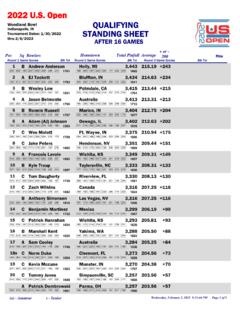Transcription of FORTRAN 90: Formatted Input/Output - Iowa State University
1 FORTRAN 90: Formatted Input/Output Meteorology 227. Fall 2021. Formatted Output Two output statements in FORTRAN . PRINT and WRITE. PRINT format-descriptor, output-list What is a format descriptor? *. A character constant or a character variable whose value specifies the format of the output. The label of a FORMAT statement Each execution of a PRINT statement displays the values in the output list on a new line. Blank output list new line Format Descriptors Specifies the format at which the values in the output list are to be displayed. * List directed output (list of format descriptors)' or (list of format descriptors).
2 Label FORMAT (list of descriptors). Label is an integer from 1 to 99999. What do format descriptors look like? Table 5-1. Example: PRINT (I3)', N. Integer printed in first 3 positions of line (right justified). Let N=320, what does it output? Let N=32, what does it output? Let's look more carefully at the format descriptors for integers, reals, and character variables. Integer output (I descriptor). Values output are right justified. Book examples (Page 96). If an integer value (including a minus sign if the number is negative) requires more spaces than specified by a descriptor, the field is filled with *'s!
3 !! Real output (F, E, ES, and EN). Like integer values, right-justified W = width of field, d = number of digits to right of decimal place. If the value has more than d digits following the decimal point, it is rounded to d digits. If the value has fewer than d digits, the remaining are filled with zeros. Book examples (Page 97). Like integers, if the real number being output requires more spaces than specified by the descriptor, the entire field is filled with *'s. w d + 3 Why? E, ES, and EN. Let A = .12345E8. E (exponential) descriptor Output displayed in normalized format A minus sign, followed by a leading zero, decimal point, d significant digits, then E.
4 Followed by the exponent in the next four spaces. +08. ES (scientific notation) descriptor Same as E, but mantissa (left of decimal point) is at least one, but less than 10. +07. EN (engineering) descriptor Same as E, except that exponent is constrained to be a multiple of 3. A non-zero mantissa is greater than or equal to 1 and less than 1000. +06. Character Output Character constants can be displayed by including them in the list of descriptors of a format statement. Book examples (Page 98). Character data may also be displayed by using an A. format descriptor, rA or rAw r is the repeatability descriptor and w is the field width.
5 Right justified If the character value exceeds the specified field width, the output consists of the leftmost w characters. Positional descriptors (X and T), Repetition, Slash nX inserts n blanks in an output line. Tc causes the output field to begin at the specified position c on the current line (tab). PRINT 75, John Q. Doe , CPSC , Number 75 FORMAT (1X, A11, 3x, A4, 2X, I3). OR. 75 FORMAT(1X, A11, T16, A4, 2X, I3). Repetition (1X, A, , A, )' can be written as (1X, 2(A, ))'. Slash descriptor (/). Causes output to begin on a new line. 88 FORMAT (1x, A, 3/ 1x, 2(I10, ) // 1x, ).
6 Formatted Input Formatted input is rarely used in the physical sciences. Typically, data is read in from files or obtained from the user as unformatted data. As a result, this is where we will place our focus. File Processing: OPEN (open-list). Unit specifier indicating a unit number connected to the file being opened. FILE = character-expression Character-expression is the name of the file to be connected to the specified unit number. STATUS = character-expression Character-expression is one of: OLD file already exits in the system. NEW file does not yet exist and is being created by the program.
7 REPLACE creates a new file, replacing the old one if it exits, and changes its status to OLD . OPEN (open-list) cont. ACTION = i-o action i-o action is a character expression whose value is one of: READ File opened for reading only. WRITE File opened for writing only. READWRITE File opened for both reading and writing. POSITION = character-expression Character expression is one of: REWIND positions file at its initial point. APPEND positions file at the end. ASIS leaves position unchanged. (default). IOSTAT = status-variable Status-variable is an integer variable. Status-variable = 0 if file is opened successfully.
8 Status-variable > 0 otherwise. Usually represents an error message found in the system manuals. Examples OPEN (UNIT = 12, FILE = , &. STATUS = OLD , ACTION = READ , &. IOSTAT = OpenStat). Typically, it is best not to hardwire UNIT and FILE. Create variables to store their values. Use single statement syntax to open several files. File Processing: CLOSE (close-list). UNIT specifier Must include at least this. IOSTAT clause STATUS clause After a file is closed, it may be re-opened using an OPEN statement. WRITE (control-list) output-list Unit specifier: integer expression whose value designates the output device, or an *.
9 UNIT = unit-specifier or *. Format specifier: may be any of the forms allowed by the PRINT statement. FMT = format-specifier or format-description ADVANCE = clause statement ADVANCE = character-expression Character-expression is either YES or NO . Should I advance to a newline after output? Default= YES . Other useful file processing commands Examples WRITE(6, *) Temperature, dewpoint WRITE(6, FMT= *) Temperature, dewpoint WRITE(UNIT = 6, FMT= *) Temperature, dewpoint WRITE(Output_Unit, *) Temperature, dewpoint WRITE(UNIT= Output_Unit, FMT = *). Temperature, dewpoint.
10 WRITE(*,*) Temperature, dewpoint. Read (control-list) input-list Unit specifier indicating the input device. Format specifier ADVANCE = clause (similar to write statement). IOSTAT = clause Used to detect an input error or and end-of-file condition. Other useful processing commands. Examples READ (5,*) time, temp, dewp READ (UNIT = 5, FMT = *) time, temp, dewp READ (IN, *) time, temp, dewp Where IN has a value of 5. File Input/Output Once a file is open, it can be written to or read from using the WRITE and READ statements. IOSTAT can be used to detect the end of file condition (EOF) or an input error.





